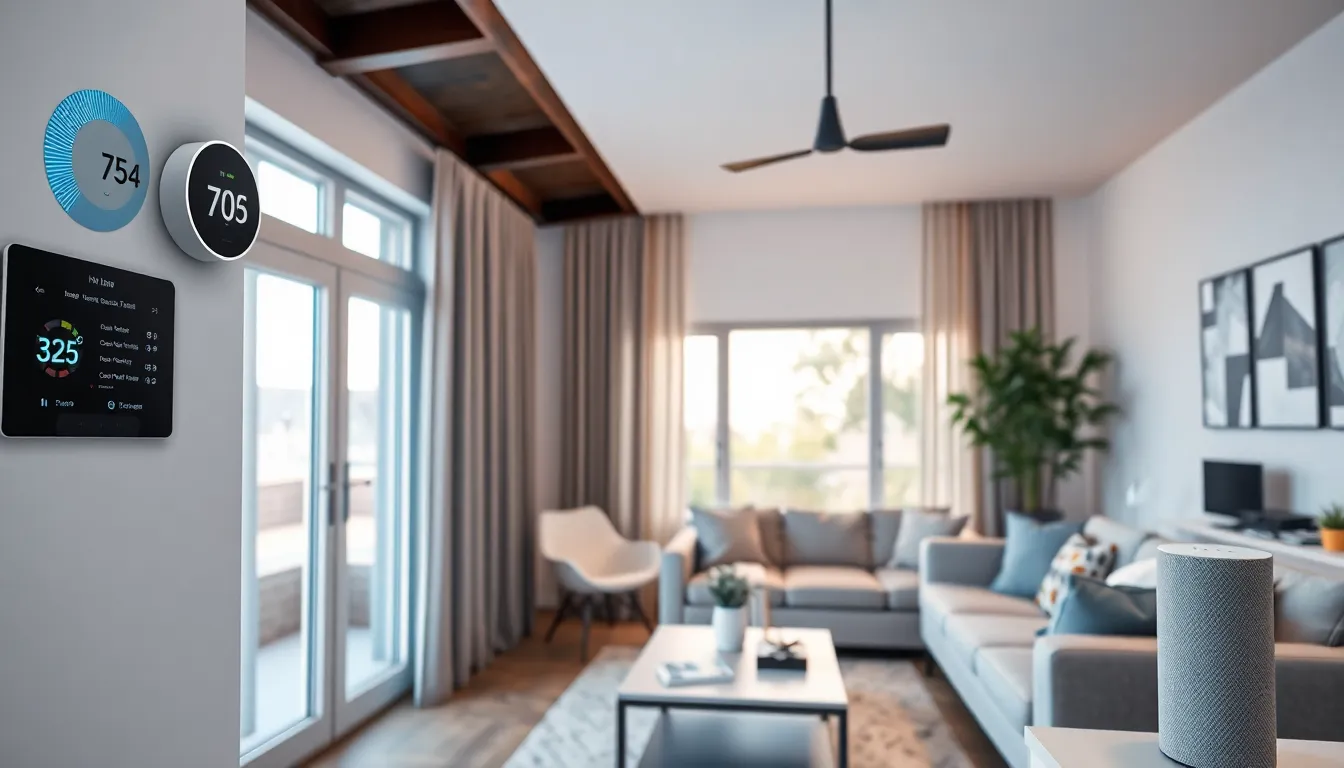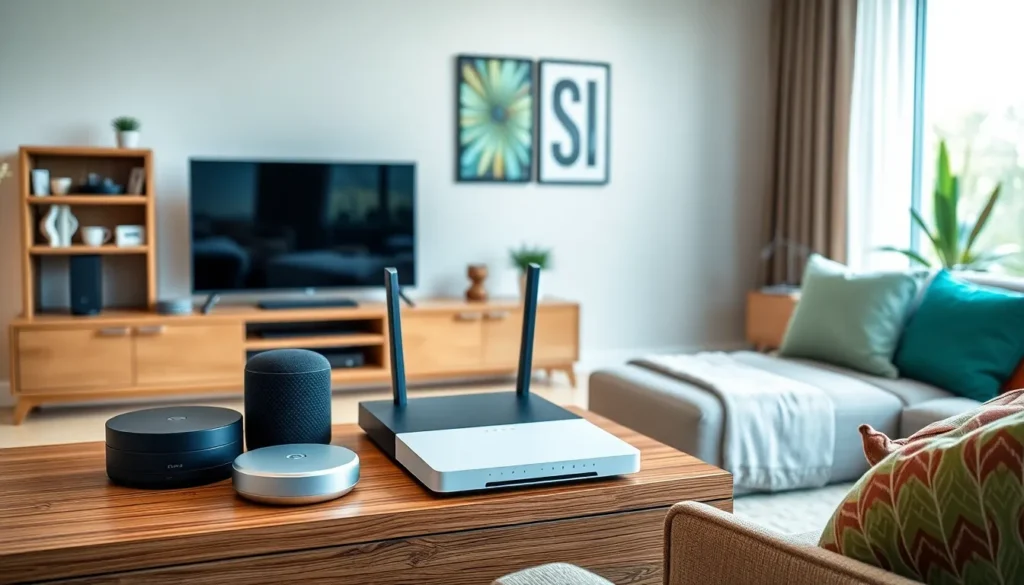As the digital landscape continues to evolve, the need for a more robust and efficient internet protocol becomes increasingly vital. IPv6, the successor to IPv4, offers a solution to the limitations of its predecessor by providing a virtually limitless number of IP addresses. This transition is especially important for home networks, where the demand for connected devices is skyrocketing.
Setting up an IPv6 home network not only future-proofs connectivity but also enhances security and performance. With smart home devices, streaming services, and online gaming becoming staples in everyday life, understanding how to implement IPv6 can significantly improve the user experience. Embracing this technology is essential for anyone looking to optimize their home network in today’s fast-paced digital world.
Table of Contents
ToggleOverview Of IPv6 Home Network
IPv6 home networks leverage the expanded address space and security features of IPv6, a protocol designed to replace the outdated IPv4. IPv6 offers 340 undecillion unique IP addresses, accommodating the growing number of devices in modern homes, including smart appliances, computers, and mobile devices.
The key components of an IPv6 home network include:
- IPv6 Addresses: Employing 128-bit addresses allows for ample allocation of IPs to each device.
- Auto-configuration: Utilizing Stateless Address Autoconfiguration (SLAAC), devices can self-configure using router advertisements, simplifying network management.
- Enhanced Security: Integrated security features, such as IPsec, provide end-to-end encryption and authentication, safeguarding communications within the home network.
Adopting an IPv6 home network improves user experiences by facilitating seamless connectivity for high-bandwidth applications like streaming and gaming. As the Internet of Things (IoT) expands, IPv6’s capabilities support a growing ecosystem of connected devices, making it imperative for households to transition from IPv4 to ensure optimal performance and connectivity.
Benefits Of IPv6 Home Network

IPv6 home networks offer several advantages that significantly enhance the functionality, security, and performance of connected devices. The benefits include improved address space and enhanced security features, crucial for modern digital landscapes.
Improved Address Space
Improved address space enables IPv6 to support a vast number of devices. With 128-bit addressing, IPv6 provides approximately 340 undecillion unique IP addresses, ensuring every device in a home network can connect without the need for address conservation techniques. This spacious framework directly addresses the limitations inherent in IPv4’s 32-bit structure, which allows for around 4.3 billion unique addresses. Thus, home networks can seamlessly accommodate an expanding array of IoT devices, such as smart thermostats, security cameras, and connected appliances, without the hassle of NAT (Network Address Translation) configurations.
Enhanced Security Features
Enhanced security features in IPv6 bolster network protection. IPv6 integrates IPsec, which supports end-to-end encryption, providing built-in security without requiring additional configuration. IPsec safeguards data transmissions between devices, protecting against threats like eavesdropping and tampering. Moreover, IPv6’s architecture facilitates the implementation of secure network policies, allowing for better management of data flow and device authentication. This security is crucial for households utilizing smart home technologies that transmit sensitive information.
Challenges Of Transitioning To IPv6
Transitioning to IPv6 presents several challenges that can impact home users and network managers alike. Understanding these challenges can facilitate smoother adoption.
Compatibility Issues
Compatibility issues arise due to the existing prevalence of IPv4. Many legacy devices and software applications do not support IPv6, limiting their functionality in an IPv6-only environment. Transitioning networks may encounter difficulties when integrating newer IPv6 devices with older IPv4 equipment. Network administrators must implement dual-stack systems that support both IPv4 and IPv6 during the transition period, which can complicate network management and increase operational costs. These compatibility hurdles can hinder a seamless migration to the IPv6 framework.
Learning Curve For Users
The learning curve for users can be significant when shifting to IPv6. Many users are accustomed to the IPv4 addressing system, and transitioning to a 128-bit address scheme presents a challenge. Users must familiarize themselves with new concepts such as Stateless Address Autoconfiguration (SLAAC) and various IPv6 addressing formats. Moreover, troubleshooting and configuration processes differ from those in IPv4, requiring additional training and resources. Providing adequate educational resources becomes essential to empower users and network managers during the transition to IPv6, ensuring efficient utilization of the new system.
Setting Up An IPv6 Home Network
Setting up an IPv6 home network involves specific requirements and a structured process. This ensures optimal performance and security for connected devices.
Requirements For IPv6 Configuration
- IPv6-Compatible Router: Ensure the router supports IPv6. Most modern routers include this feature, but verification is crucial.
- IPv6-Enabled Devices: Confirm that devices like smartphones, computers, and smart home products support IPv6. This support facilitates seamless connectivity.
- ISP Support: Check if the Internet Service Provider (ISP) offers IPv6 connectivity. ISPs provide necessary IPv6 addresses and handle network transitions.
- Firmware Updates: Update the router and device firmware to the latest versions. This step enhances compatibility and security features.
- Network Configuration Tools: Access network management tools provided by the router. These tools assist in configuring IPv6 settings efficiently.
Step-By-Step Setup Process
- Access Router Settings: Log into the router’s settings page through a web browser using the router’s IP address.
- Navigate to IPv6 Settings: Locate the IPv6 configuration section within the router’s interface, often found under advanced settings.
- Enable IPv6: Toggle the IPv6 option to enable functionality. Save the changes to apply the configuration.
- Select Connection Type: Choose the appropriate connection type, such as DHCPv6 or static addressing, as specified by the ISP.
- Configure Addressing: Input any IPv6 addresses, if necessary. Depending on the ISP’s guidelines, this step may vary.
- Save and Reboot: Save the configuration settings, then reboot the router for changes to take effect.
- Test the Connection: Verify the network connection by checking the device’s IPv6 connectivity. Use online tools to confirm successful setup.
- Monitor the Network: Regularly check IPv6 connectivity and performance using network monitoring tools. This step ensures ongoing optimal functionality.
Future Of IPv6 Home Networking
The future of IPv6 home networking centers on enhanced connectivity and improved user experiences. As the number of smart devices grows, IPv6’s vast address space accommodates more devices seamlessly. This ensures reliable connections for applications like home automation, virtual reality, and 4K streaming.
IPv6 supports advancements in network performance through features like Quality of Service (QoS). QoS enables prioritization of bandwidth for essential devices, such as gaming consoles and streaming devices, minimizing latency and buffering issues. Improved performance leads to higher satisfaction among users, particularly in households with multiple active connections.
Security also advances with IPv6. Built-in IPsec simplifies the implementation of encryption across devices, offering robust protection against cyber threats. Households can experience a higher level of security, enabling safe transactions and interactions among connected devices.
Further developments in IPv6 home networking include support for new protocols and technologies. Emerging technologies like Network Slicing and Software-Defined Networking (SDN) utilize IPv6’s features to create efficient, tailored networking solutions. Adopting these technologies allows households to optimize resources based on specific needs.
Transitioning to IPv6 presents opportunities for innovative services. As providers embrace IPv6, users gain access to next-generation applications, including enhanced cloud services and virtual environments. This evolution fosters a more connected and intelligent ecosystem for homes.
Ultimately, the future of IPv6 home networking promises unparalleled connectivity, security, and performance for connected devices. As technology evolves, IPv6 will play a crucial role in shaping the landscape of digital connectivity, meeting the demands of modern households.
Transitioning to an IPv6 home network is essential for anyone looking to future-proof their digital environment. With the increasing number of connected devices and the demand for higher performance, IPv6 offers a robust solution that addresses the limitations of its predecessor.
By embracing IPv6, users can enjoy enhanced security, improved connectivity, and seamless integration of smart technologies. The benefits extend beyond just address space; they include better management tools and advanced features that optimize user experience.
As the digital landscape continues to evolve, adopting IPv6 will play a pivotal role in ensuring that home networks remain efficient and secure. This transition not only supports current needs but also paves the way for future innovations in technology.





